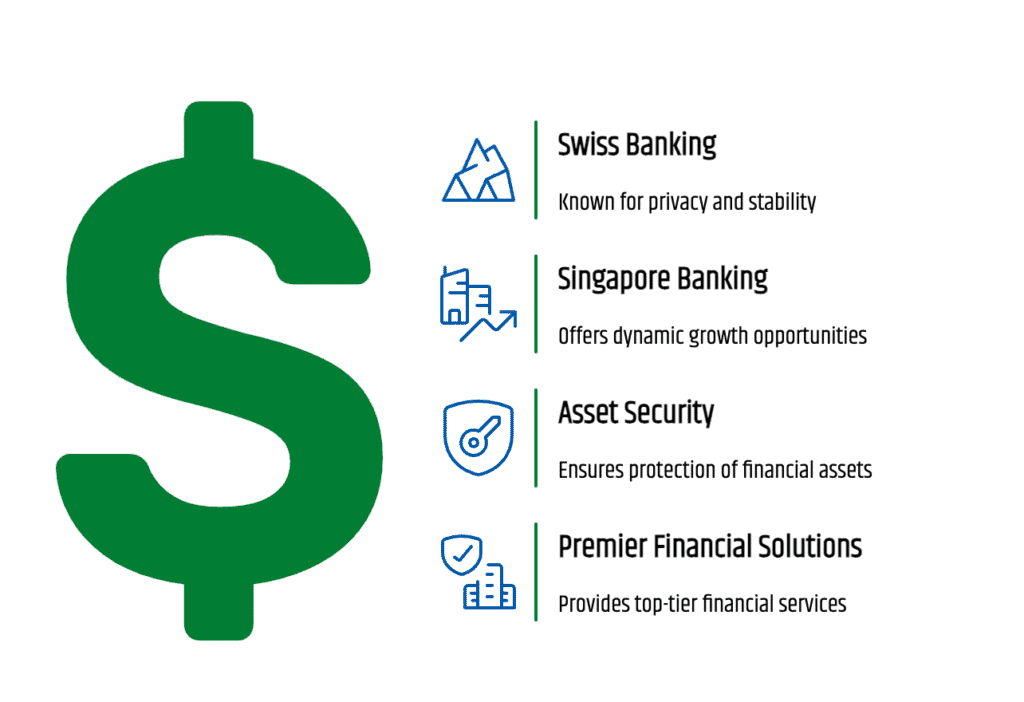Every international account holder confronts the same critical question: Which bank truly protects your deposits? Most people rely on credit ratings or brand reputation to answer this question. However, you deserve better. This comprehensive guide reveals how to evaluate foreign banks using professional financial metrics—the same standards that banking regulators and institutional investors apply when determining institutional safety. By mastering this framework, you transform bank evaluation from guesswork into data-driven decision-making.
The traditional approach fails depositors because credit ratings measure debt service capability, not institutional viability. Regulatory minimums represent legal compliance floors, not safety ceilings. You require a professional evaluation framework combining credit ratings, regulatory metrics, and institutional scale analysis. This guide equips you with exactly that framework.
Understanding Credit Ratings: Separate Hype From Genuine Safety Assessment
Credit ratings seem straightforward on the surface. Moody’s, Standard & Poor’s, and Fitch assign letter grades predicting whether banks will service debt obligations on schedule. However, you must recognize a critical distinction: credit ratings are entirely voluntary assessments, not regulatory requirements.
Here’s what you need to understand: No regulatory minimum exists for credit ratings. A bank can legally operate without any credit assessment from rating agencies whatsoever. Some institutions—particularly regional banks, private banks, or those valuing confidentiality—deliberately choose not to seek ratings.
This distinction matters profoundly for your evaluation strategy. A bank lacking a credit rating isn’t automatically unsafe. Conversely, a bank carrying an investment-grade rating isn’t automatically secure. Rating agencies measure one specific dimension: whether the bank services debt payments on schedule. They don’t measure institutional viability, stress resilience, or deposit security.
Two fundamental rating categories exist: investment grade and speculative grade. Investment grade (BBB-/Baa3 and higher) indicates relatively low credit risk. Speculative grade (BB+/Ba1 and lower) signals elevated default risk. Therefore, you should avoid speculative-grade banks unless exceptional circumstances and extraordinary financial strength justify consideration.
Moreover, upper investment grades (A-/A3 and better) demonstrate substantially stronger correlation with actual default risk than lower investment grades. Research from the European Central Bank reveals this critical insight: A-rated banks prove statistically safer than BBB-rated banks because rating agencies apply more rigorous standards to upper investment grades.
Your recommended approach combines credit rating assessment with fundamental financial analysis. Treat investment-grade ratings as a necessary starting threshold, not a sufficient safety guarantee.
Regulatory Minimums vs. Safety Thresholds: Knowing the Critical Difference
You must understand a fundamental distinction that separates compliant banks from genuinely safe institutions: regulatory minimums establish legal compliance floors, not safety ceilings.
Basel III establishes binding minimum capital and liquidity requirements that regulators legally enforce. Banks falling below these minimums face regulatory sanctions, capital orders, or closure. Consequently, regulatory minimums matter—they identify banks in legal violation. However, banks meeting only regulatory minimums often remain fragile and vulnerable to stress.
Here are the actual Basel III regulatory minimums::
- CET1 Ratio: Minimum 4.5%
- Tier 1 Capital Ratio: Minimum 6%
- Total Capital Ratio: Minimum 8%
- Liquidity Coverage Ratio (LCR): Minimum 100%
- Net Stable Funding Ratio (NSFR): Minimum 100%
Now compare these regulatory minimums to genuine safety thresholds. You should require substantially higher standards for your deposits:
- CET1 Ratio: 15%+ (NOT 4.5%)
- Tier 1 Capital Ratio: 15%+ (NOT 6%)
- Total Capital Ratio: 15%+ (NOT 8%)
- LCR: 120%+ (NOT 100%)
- NSFR: 110%+ (NOT 100%)
Why does this distinction prove so critical? A bank maintaining exactly 4.5% CET1 can absorb losses within narrow margins before facing regulatory intervention. A bank maintaining 15% CET1 absorbs substantial portfolio deterioration while maintaining positive regulatory capital ratios and continued normal operations.
Consider a practical example: Two banks experience identical 10% loan portfolio deterioration. Bank A maintains 4.5% CET1 on CHF 10 billion risk-weighted assets (CHF 450 million capital). The 10% loss (CHF 1 billion on a CHF 10 billion portfolio) consumes 222% of CET1 capital, triggering immediate regulatory intervention. Bank B maintains 15% CET1 (CHF 1.5 billion). Identical 10% losses consume only 67% of CET1 capital, leaving the bank operationally sound with substantial capital remaining.
Therefore, never confuse regulatory compliance with genuine safety.
Why Institutional Scale Determines Stress Resilience
Your bank’s total asset size predicts stress resilience more reliably than most investors realize. Size creates multiple protective mechanisms that smaller institutions simply cannot replicate.
A bank with CHF 2 billion in assets operates fundamentally differently than a CHF 10 billion institution. Consider the operational dimension: Larger banks maintain sophisticated infrastructure distributed across multiple locations and geographic markets. They operate backup systems, maintain diverse staffing, and distribute operational risks. Smaller banks—particularly those below CHF 2 billion—typically operate from single headquarters with concentrated operational teams. System failures, key personnel departures, or regional crises create proportionally greater operational impact for smaller institutions.
Portfolio diversification amplifies this difference significantly. A CHF 5 billion bank with CHF 3 billion in loans maintains lending relationships across 5,000 to 10,000+ individual customers spanning multiple industries and geographies. A CHF 500 million bank maintains perhaps 200 to 500 relationships, often concentrated in single industries or regions. Economic stress affecting construction, technology, or energy sectors creates proportionally greater portfolio damage for concentrated lenders.
Regulatory attention strengthens this advantage further. Larger banks exceeding CHF 5 billion in assets receive intensive regulatory scrutiny, frequent examinations, and sophisticated supervisory oversight. Enhanced regulatory monitoring creates early warning systems identifying problems before they threaten depositor security. The Federal Deposit Insurance Corporation, European Central Bank, and Swiss National Bank dedicate substantially more examination resources to larger institutions.
You should establish CHF 5 billion in total assets as your minimum institutional safety threshold. This threshold represents genuine institutional scale with adequate diversification and operational resilience. For maximum safety, you should prefer institutions maintaining CHF 10 billion or higher in total assets, demonstrating enhanced financial strength and proven resilience through multiple economic cycles.
Why Private Banks Require $10 Billion Minimum AUM for Genuine Diversification
Assets Under Management (AUM) creates concentration risk that directly threatens private banking stability. Your evaluation framework must account for this distinct private banking dynamic.
Major international wealth managers demonstrate why scale matters critically. Citi Private Bank manages approximately 13,000 ultra-high-net-worth clients across global locations, with no single client representing material AUM concentration. Lombard Odier, a major Swiss private bank, added 265,000 new clients during 2024 alone, bringing CHF 44 billion in new assets. These institutions achieve what smaller competitors cannot: genuine client diversification.
Conversely, smaller private banks face extreme concentration vulnerabilities. Data from Hong Kong private banking markets reveals that relationship managers typically serve 20 to 50 clients each, with average AUM per relationship manager of USD 300 to 400 million. A private bank with CHF 3 billion AUM and 50 relationship managers serves approximately 2,500 clients. More critically, top 10 clients represent 40 to 60% of total AUM, creating extreme revenue concentration.
This concentration translates directly into vulnerability. When major clients depart—whether due to client death, retirement, or relationship dissolution—they create material revenue losses. A CHF 3 billion AUM bank losing one major client (perhaps CHF 200 to 500 million) experiences 7 to 17% revenue contraction. A CHF 20 billion bank experiencing identical percentage client loss absorbs the impact much more easily.
Profitability directly correlates with AUM scale.
Swiss private banks with AUM below CHF 5 billion averaged ROE (return on equity) of only 9.6%, while those with AUM between CHF 10 billion to CHF 50 billion exceeded 11%+. This 150+ basis points profitability gap reflects precisely the cost structure pressures and revenue concentration risks smaller banks face.
Therefore, you should require private banks to maintain minimum CHF 10 billion AUM for adequate diversification. For enhanced safety, you should prefer private banks exceeding CHF 15 billion AUM, demonstrating exceptional diversification with top 10 clients typically representing less than 20% of revenue.
Basel III Capital Requirements: Distinguishing Legal Minimums From Genuine Safety Standards
Basel III establishes binding capital requirements ensuring banks maintain sufficient loss-absorbing capacity. However, you must recognize that these regulatory minimums represent legal floors, not safety ceilings.
Common Equity Tier 1 (CET1) capital represents your primary protection against institutional failure. CET1 absorbs losses without conversion, deferral, or restructuring requirements. Basel III mandates a minimum CET1 ratio of 4.5%. Yet this regulatory minimum proves deceptively low for safety evaluation purposes.
Evidence from the European Central Bank reveals the reality: Healthy eurozone banks maintain CET1 ratios averaging 16.3%—more than triple the regulatory minimum. UBS maintains 14.3% CET1. Swiss cantonal banks like BCV exceed 18.4% CET1. These institutions demonstrate that truly safe banks operate far above regulatory minimums.
You should require CET1 ratios of 15%+ for your deposits. This threshold ensures sufficient capital to absorb substantial portfolio impairments while maintaining positive regulatory capital ratios.
Consider this practical comparison: Two banks experience identical 15% loan portfolio deterioration on CHF 10 billion loan books (CHF 1.5 billion losses). Bank A maintains 6% CET1 (CHF 600 million on CHF 10 billion risk-weighted assets). The loss consumes 250% of CET1 capital, triggering immediate regulatory intervention and potential restructuring. Bank B maintains 15% CET1 (CHF 1.5 billion). Identical losses consume precisely 100% of CET1 but the bank maintains regulatory capital ratios and continues normal operations.
Total Tier 1 capital—combining CET1 with Additional Tier 1 instruments—reveals complete going-concern loss-absorption capacity. Healthy institutions maintain Tier 1 capital ratios of 15%+, demonstrating genuine loss-absorption strength.
Liquidity Metrics: Ensuring Your Bank Survives Funding Stress
Liquidity crises threaten even well-capitalized banks. During the 2008-2009 financial crisis, numerous solvent institutions collapsed because they couldn’t access funding to meet deposit withdrawal demands.
Basel III addresses this vulnerability through liquidity requirements that ensure banks maintain sufficient cash and liquid assets to survive severe funding disruptions.
The Liquidity Coverage Ratio (LCR) measures whether your bank survives 30-day funding stress. The LCR divides high-quality liquid assets by projected net cash outflows during acute stress scenarios. Basel III requires minimum 100% LCR.
However, 100% LCR means the bank survives exactly 30 days of significant deposit withdrawals without external funding—a razor-thin margin. You should require 120%+ LCR, providing multi-week survival capacity beyond minimum regulatory thresholds. BBVA reported 149% LCR in recent disclosures, meaning it could survive 42+ days of hypothetical severe stress without emergency funding. This 49% buffer above minimum represents conservative liquidity management.
The Net Stable Funding Ratio (NSFR) addresses longer-term funding stability across one year. NSFR divides available stable funding by required stable funding over a one-year horizon. Basel III requires minimum 100% NSFR. You should require 110%+ NSFR for genuine stability, with enhanced institutions maintaining 120%+ ratios.
Enhanced Bank Safety Framework: Basel III Minimums vs. Standard Safety vs. Enhanced Capital Position
Consequently, banks meeting only regulatory liquidity minimums face elevated vulnerability during extended funding stress. Your evaluation framework must verify both LCR and NSFR exceed comfortable buffers above minimums.
Non-Performing Loans: The Hidden Risk Indicator That Predicts Future Stress
Non-performing loans (NPLs) reveal what losses your bank actually expects to experience, not just what it can theoretically absorb.
NPLs represent loans where borrowers have missed payments by 90+ days, signaling deteriorating credit quality and elevated loss probability. High NPL ratios directly reduce profitability by forcing capital allocations to loan loss provisions, constraining earnings growth and limiting capital expansion.
A healthy bank maintains NPL ratios below 2%, indicating excellent loan portfolio quality. Data from EU/EEA banks during Q2 2025 shows NPLs totaling EUR 372.6 billion represented just 1.84% of total loans, indicating strong portfolio quality sector-wide.
NPL ratios between 2-5% suggest normal economic conditions with acceptable portfolio quality. However, NPL ratios exceeding 5% represent deteriorating asset quality, often signaling either macroeconomic stress or poor underwriting standards.
Importantly, high NPLs combined with weak capital create dangerous combinations. A bank claiming 14% CET1 capital but maintaining 8% NPLs faces greater stress risk than a bank with 12% CET1 and <1% NPLs. Why? The first institution allocates substantial capital to provisions for expected losses, limiting genuine loss-absorption capacity. The second bank demonstrates superior credit risk management and capital efficiency.
Therefore, evaluate NPL trends carefully. Are losses increasing, stable, or declining? Deteriorating NPL ratios warrant additional investigation regardless of other positive metrics.
Return on Equity and Return on Assets: Measuring Sustainable Profitability
Profitability metrics reveal whether your bank generates stable earnings or faces deteriorating business conditions.
Return on Equity (ROE) measures profitability as a percentage of shareholder capital. Healthy bank ROE typically ranges between 5-10% annually, reflecting post-Basel III operational constraints and current market conditions. EU/EEA banks reported 10.7% ROE during Q2 2025, reflecting elevated net interest margins from higher interest rates.
However, you should prioritize consistency over peak profitability in any single year. Banks maintaining steady 5-10% ROE across multiple years—including challenging economic periods—demonstrate fundamental business strength. Conversely, banks showing boom-bust profitability patterns (high ROE during favorable years, massive losses during recessions) indicate cyclical vulnerability.
Return on Assets (ROA) measures absolute profitability efficiency. ROA equals net income divided by total assets. You should require 0.5% minimum ROA, reflecting realistic profitability in current banking environment. Banks exceeding 0.8% ROA demonstrate enhanced profitability and operational excellence.
ROA below 0.3% suggests operational inefficiency or deteriorating profitability, while negative ROA indicates actual losses. For your evaluation, institutions consistently exceeding 0.5% ROA demonstrate sustainable, efficient operations.
Cost-to-Income Ratios and Operational Efficiency: Identifying Well-Managed Institutions
Cost-to-income ratios reveal how efficiently your bank converts revenue into profit.
This metric (operating expenses divided by operating income) indicates how much a bank spends generating each unit of revenue. Lower ratios demonstrate superior operational efficiency and profitability sustainability.
Industry benchmark cost-to-income ratios operate as follows:
- <60%: Exceptional efficiency
- 60-70%: Strong performance
- 70-80%: Acceptable efficiency
- >80%: Operational challenges
The European Union banking sector averaged 52.37% cost-to-income ratio in Q3 2024, reflecting strong industry efficiency overall. Swiss private banks achieved median cost-to-income ratios of 73-74%, slightly above EU averages but within acceptable ranges.
Banks with deteriorating cost-to-income ratios warrant concern. Rising costs relative to revenue can indicate either declining revenue from competitive pressure or rising expenses from inflation, technology investment, or fraud management. The most concerning pattern combines rising cost-to-income ratios with declining profitability, suggesting operational pressures the institution failed to control.
Consequently, evaluate these trends carefully throughout your bank evaluation process.
Building Your Comprehensive Bank Safety Assessment Framework
Your evaluation framework combines credit rating assessment with fundamental financial analysis, creating a professional decision-making process.
Step 1: Verify Credit Rating (If Available)
- Does the bank carry investment-grade rating (BBB-/Baa3 or better)?
- Prefer banks rated A-/A3 or higher when available
- Avoid speculative-grade banks (BB+/Ba1 or lower)
- Accept banks with no credit rating—evaluate through financial metrics instead
Next Step 2: Confirm Legal Regulatory Compliance
- Does the bank maintain CET1 ≥4.5%?
- Does the bank maintain Tier 1 ≥6%?
- Does the bank maintain Total Capital ≥8%?
- Does the bank maintain LCR ≥100%?
- Does the bank maintain NSFR ≥100%?
→ If NO to any, the bank violates regulatory minimums—reject immediately
Step 3: Evaluate for Genuine Safety (Beyond Minimums)
- CET1 ≥15% (not just 4.5%)
- Tier 1 ≥15% (not just 6%)
- Total Assets ≥CHF 5 billion
- LCR ≥120% (not just 100%)
- NSFR ≥110% (not just 100%)
- NPL <2%
- ROE 5-10% consistently
- ROA >0.5%
Next Step 4: Verify Institutional Scale
- Total assets exceed CHF 5B minimum
- For private banks: AUM exceeds CHF 10B minimum
- Equity capital exceeds CHF 500M
- Diversified client base (not concentrated large depositors)
Step 5: Examine Regulatory Status
- Confirm specific banking license in regulated jurisdiction
- Verify regulatory authority (ECB, SNB, Fed/OCC, MAS)
- Review recent regulatory sanctions or enforcement actions
- Verify deposit insurance coverage and limits
Quick Reference: Bank Safety Evaluation Table
| Financial Metric | Regulatory Minimum | Recommended for Safety | Enhanced Safety | Red Flag If |
|---|---|---|---|---|
| Credit Rating | NONE | Investment Grade (BBB-/Baa3+) | A-/A3 or Better | Speculative Grade or Negative Outlook |
| CET1 Ratio | 4.5% | 10-12% | 15%+ | <6% |
| Tier 1 Ratio | 6% | 12% | 15%+ | <8% |
| Total Capital | 8% | 12% | 15%+ | <8% |
| LCR | 100% | 120%+ | 130%+ | <100% |
| NSFR | 100% | 110%+ | 120%+ | <100% |
| NPL Ratio | NONE | <2% | <1.5% | >5% |
| ROE | NONE | 5-10% | 10-12% | Negative |
| ROA | NONE | >0.5% | >0.8% | <0.3% |
| Cost-to-Income | NONE | <70% | <60% | >80% |
| Total Assets | Varies | $5B+ | $10B+ | <$500M |
| Private Bank AUM | NONE | $10B+ | $15B+ | <$2B |
Transform Your Banking Strategy Today
Ready to evaluate foreign banks using professional financial metrics instead of guessing? Open a foreign bank account today with Easy Global Banking — where expert advisors guide you through comprehensive bank evaluation combining credit rating assessment, regulatory compliance verification, and institutional scale analysis.
Our specialists verify that candidate banks either carry investment-grade ratings or demonstrate exceptional financial strength, exceed regulatory minimums by substantial margins, and maintain institutional scale of CHF 5 billion+ total assets.
For comprehensive offshore banking relationships, Open Swiss Bank Account services provide detailed analysis for Swiss institutions with investment-grade ratings, CET1 ratios far exceeding regulatory minimums, and state-backed cantonal guarantees ensuring maximum deposit protection.
For Asian market development, Open Bank Account Singapore services feature banks demonstrating superior institutional scale, capital adequacy exceeding international standards, and MAS regulatory oversight.
Transform your approach to international banking today. Move beyond relying on credit ratings alone to leveraging professional regulatory financial analysis and institutional scale verification. Start your bank evaluation with Easy Global Banking—where sophisticated financial analysis becomes the foundation for secure international banking relationships.





